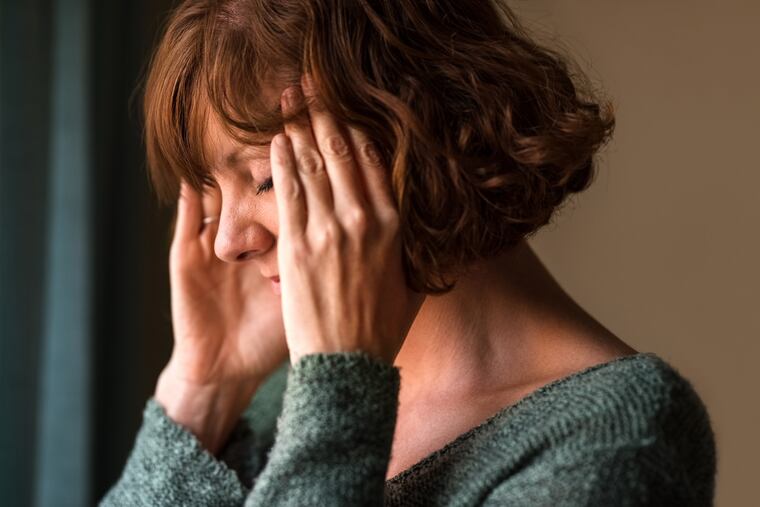What it’s really like to live with chronic migraines | Patient Perspective
First, I recognized the symptoms. Second, I accepted them, without minimizing. Third, I told my husband what was happening. Fourth, I said what I needed to take care of myself. This is major progress.

On a recent cloudy spring morning, I sat down at the dining room table, and found I was squinting. The chandelier, though dim, hurt my eyes. I shaded my eyes with a hand, aware that healthy people don’t have to shade their eyes at 7 a.m. on a rainy day. Propping my head up with my hand, I tried to listen to my husband, but I could feel the now familiar signs bearing down on me like a train: pressure building in my skull, tension in my jaw, pain in my neck. I told him I had a migraine starting and that I needed to rest.
This is major progress. First, I recognized the symptoms. Second, I accepted them, without minimizing. Third, I told my husband what was happening. Fourth, I said what I needed to take care of myself. After two decades of living with migraine, these are new behaviors, major victories. In the past, I would deny, even to myself, how severe the symptoms were, and push myself through my day, pretending that I was okay. Usually, that led to longer episodes.
For me, migraine is like an obnoxious relative; someone who shows up unannounced and expects you to drop everything to cater to their every need. Indefinitely. After they leave, you spend countless hours strategizing, building walls around your house, digging a moat, but it doesn’t work. Whatever you do, the relative finds you and shows up, over and over, for the rest of your life.
It is difficult and humbling to accept that my health is sometimes so compromised. I feel like somehow it is my fault, and if I just found the magic formula of diet, exercise, meditation, and self-care, then I would never have another migraine. And yet, I have spent twenty years trying to find that formula, and it eludes me.
What brings relief is awareness, acceptance, and then responding to what is actually happening in any given moment.
On that recent morning, I escaped to our bedroom, grateful for the quiet and dark. Sometimes if I stop everything, take medicine, meditate or rest, ice my head, block out any light and most sound, the migraine doesn’t blossom into a fully debilitating episode.
Sometimes nothing works.
And I never know what kind of episode it’s going to be.
This particular spring day, after about two hours of rest and meditation in my dark bedroom, I sat up, then stood up. I could remain upright, and the pain had numbed. So even though I was still groggy and tired, I went to check on my 8-year-old, then made us lunch.
I limited my physical activity for the rest of the day. I took care of my 7-month-old baby, watched Beauty and the Beast with the 8-year-old. After that I took the dog for a slow walk, still sluggish, but grateful to be moving and outside. I called the neurologist, spoke to Susan, the nurse practitioner, who, though lovely, I wish I didn’t know quite so well. We made an action plan about getting insurance coverage for a new preventative medicine.
At 7:30 pm, I put on my pajamas and got ready for bed. My head didn’t hurt exactly; it was more like my brain felt too big for my skull. I felt some pulsing on top of my head, I felt fuzzy, I felt fatigued though not sleepy. Even the dim bedside light hurt my eyes, so I turned it off.
That is a day with a migraine. Would I feel better the next day? I hoped so, but I didn’t know. I never know.
This disease affects 1 out of every 7 people in the world. That is 14% of the world’s population. A recent study found that in the United States, 1 in 6 people and 1 in 5 women reported a migraine over a 3-month period; statistics that have been stable for 19 years.
Do you sometimes wish your head could be amputated without you actually dying? Do you get very painful headaches that cause you to miss work or school and are accompanied by other symptoms? You may have migraine. (If you take two Advil, feel better after a couple hours, and don’t think about it again, that is a headache, but not a migraine.)
If any of this sounds too familiar, you don’t have to suffer alone. Seek help from doctors, therapists, support groups like Chronic Pain Anonymous, CHAMP, Move Against Migraine. I am learning how to have a rich and full life regardless of my physical health. I wish the same for everyone who lives with a chronic illness.
Julie Owsik Ackerman is a legal writer and editor. She teaches a creative writing workshop for women in Narberth, Pa.